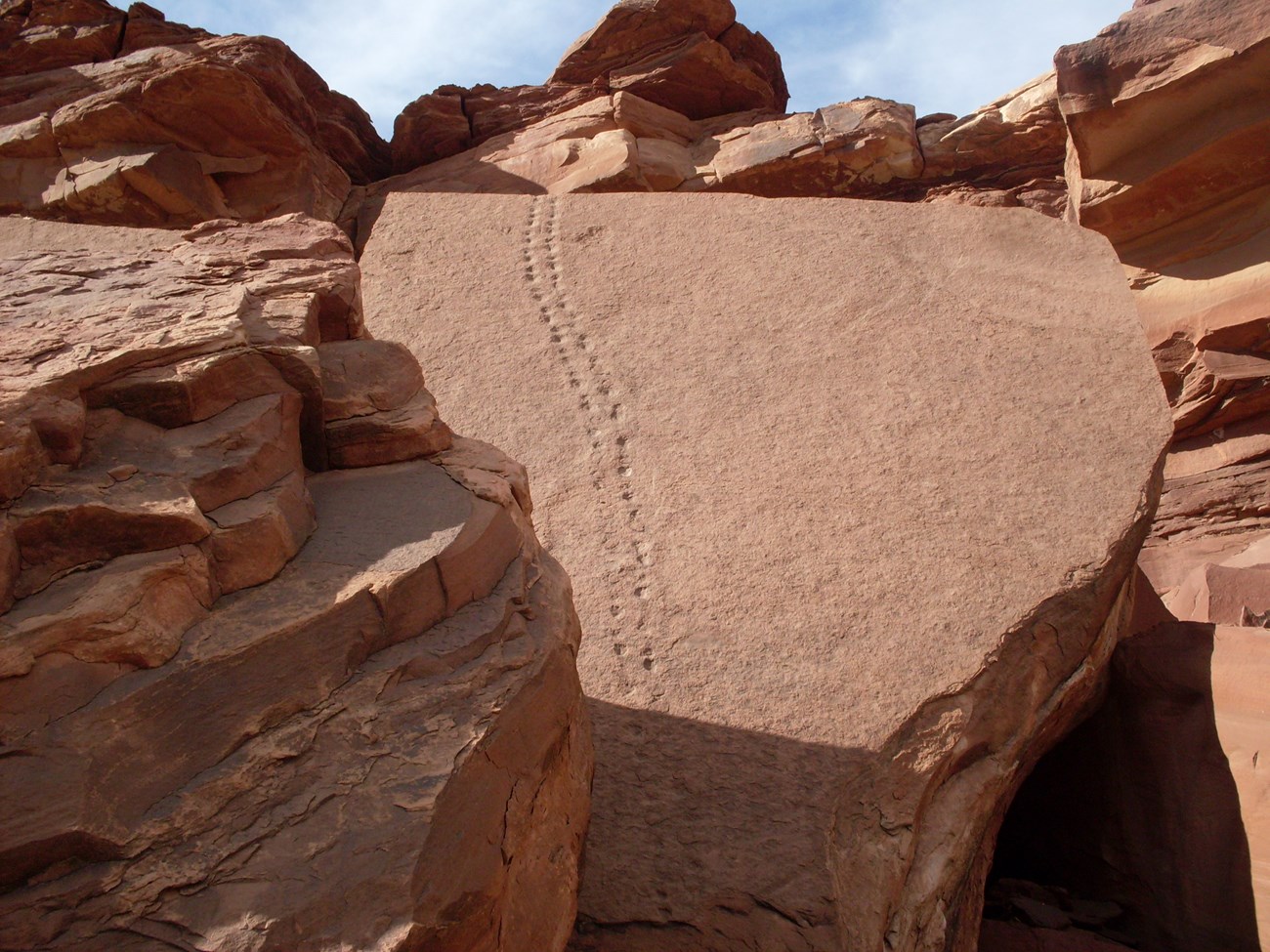[Site Under Development]

NPS photo.
Introduction
The record of the past activities of extinct organisms is preserved as trace fossils in sediment, rock, and wood. Trace fossils are very rarely transported out of their original substrate. In the majority of cases, trace fossils represent activities that occurred exactly where they are found (Martin 1996). Trace fossils have many useful advantages for studying ancient life. Because environmental factors often influence activities, trace fossils provide important clues to the original conditions of ancient environments. Trace fossils reflect environmental factors such as salinity, oxygen levels, energy, interactions among organisms, and food supplies (Martin 1996). Trace fossils provide insights into an organism’s behavior. By studying modern and ancient traces, ichnologists use a comparative approach that looks at how traces are made and how they get preserved in the fossil record (Martin 1996).
Examples of trace fossils from the National Park System include:
-
Jurassic-age termite nests at Glen Canyon and Curecanti national recreation areas in Utah and Colorado respectively,
-
burrows of prehistoric beavers at Agate Fossil Beds National Monument in Nebraska,
-
crayfish burrows at Colorado National Monument in Colorado, and
-
insect chew marks on fossil leaves at Florissant Fossil Beds National Monument in Colorado.
The Copper Canyon track site in Death Valley National Park is one of the best assemblages of trace fossils in the world.
Insect Traces
In addition to chew marks, insect trace fossils include beetle dung and nests of wasps, bees, and termites. Insect trace fossils are known from different localities and ages throughout the world. During and after the Cretaceous Period, insect trace fossils show an intimate interrelationship, some might say coevolution, between insects and flowering plants.
Coprolites
Another kind of trace fossil is fossilized dung called coprolite, which provides valuable clues to the diet of fossil organisms. Coprolites aid paleontologists in reconstructing ecosystem relationships of fossil plants and animals, for example, sloth dung, which contains pollen and microvertebrates. Only 10 caves in the world are known to preserve sloth dung; six of these caves are in the National Park System—two at Grand Canyon National Park in Arizona and four at Guadalupe Mountains National Park in Texas.
Eggs and Nests
Eggs and nests are indirect evidences of reproductive behavior, and their fossilized equivalents are trace fossils. As structures that were primarily made for facilitating the development of younger animals, nests may or may not include eggs. Some dinosaur eggs have preserved embryo remains (which are “body fossils”), but the egg itself is a trace fossil. The Oligocene “duck eggs” at Badlands National Park in South Dakota are a noteworthy fossil find.
Related Stories
Featured Parks
-
Agate Fossil Beds National Monument (AGFO), Nebraska—[AGFO Geodiversity Atlas] [AGFO Park Home] [AGFO npshistory.com]
-
Badlands National Park (BADL), South Dakota—[BADL Geodiversity Atlas] [BADL Park Home] [BADL npshistory.com]
-
Canyonlands National Park (CANY), Utah—[CANY Geodiversity Atlas] [CANY Park Home] [CANY npshistory.com]
-
Capitol Reef National Park (CARE), Utah—[CARE Geodiversity Atlas] [CARE Park Home] [CARE npshistory.com]
-
Colorado National Monument (COLM), Colorado—[COLM Geodiversity Atlas] [COLM Park Home] [COLM npshistory.com]
-
Curecanti National Recreation Area (CURE), Colorado—[CURE Geodiversity Atlas] [CURE Park Home] [CURE npshistory.com]
-
Death Valley National Park (DEVA), California and Nevada—[DEVA Geodiversity Atlas] [DEVA Park Home] [DEVA npshistory.com]
-
Denali National Park and Preserve (DENA), Alaska—[DENA Geodiversity Atlas] [DENA Park Home] [DENA npshistory.com]
-
Glen Canyon National Recreation Area (GLCA), Arizona and Utah—[GLCA Geodiversity Atlas] [GLCA Park Home] [GLCA npshistory.com]
-
Grand Canyon National Park (GRCA), Arizona—[GRCA Geodiversity Atlas] [GRCA Park Home] [GRCA npshistory.com]
-
Guadalupe Mountains National Park (GUMO), Texas—[GUMO Geodiversity Atlas] [GUMO Park Home] [GUMO npshistory.com]
-
Florissant Fossil Beds National Monument (FLFO), Colorado—[FLFO Geodiversity Atlas] [FLFO Park Home] [FLFO npshistory.com]
-
Hawai’i Volcanoes National Park (HAVO), Hawai’i—[HAVO Geodiversity Atlas] [HAVO Park Home] [HAVO npshistory.com]
-
Rio Grande Wild and Scenic River (RIGR), Texas—[RIGR Geodiversity Atlas] [RIGR Park Home] [RIGR npshistory.com]
-
White Sands National Monument (WHSA), New Mexico—[WHSA Geodiversity Atlas] [WHSA Park Home] [WHSA npshistory.com]
Last updated: December 11, 2024
